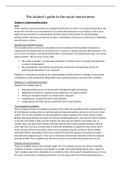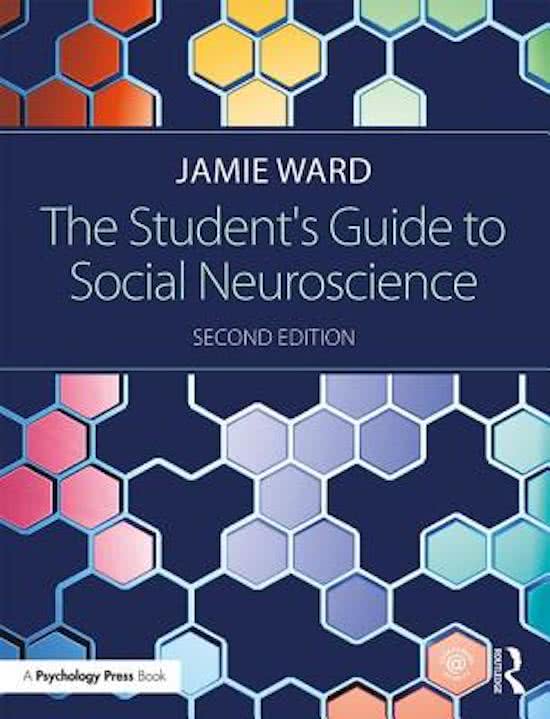The student’s guide to the social neuroscience
Chapter 6: Understanding others
Intro:
There might be a general tendency to simulate the behaviour of others on ourselves (internally in the
brain) even if we do not overly reproduce it (as observable behaviour on our bodies). In this case it
might also be important to understand the mental states of others which are the knowledge,
feelings, beliefs, intentions and desires of others. Mentalizing is the process of inferring or attributing
mental states to others.
Empathy and simulation theory:
The simulation theory is the basic assumption that we understand other people’s behaviour by
creating the mental processes on ourselves that, if carried out, would reproduce their behaviour. We
use our own recreated or simulated mental states to understand, and empathically share, the mental
states of others. This can occur in two ways:
1. We create an explicit , narrative-like simulation of another person’s situation and behaviour
in order to understand it
2. We automatically, and perhaps unconsciously, activate the corresponding circuits for
producing this behaviour in our own brain
Empathy is an emotional reaction to (or understanding of) another person’s feelings. It also has the
contemporary name perspective taking which means putting oneself in someone else’s situation.
Empathy as a multi-faceted concept:
Empathy has multiple aspects:
Knowing another person’s internal state, including thoughts and feelings
Adopting the posture or matching neural response of an observed other
Having an emotional reaction to someone else’s situation
Imagining how I would feel/react in that situation
Imagining how the other person would feel/react in that situation
From imitation to empathy:
Most simulation theories of empathy are based on the notion of perception-action coupling which is
the link between seeing actions on other people and reproducing those actions on one’s own motor
system. The neural mechanism for this perception-to-action coupling is the mirror neuron system.
Besides that being imitated increases the chances of helping behaviour, and a person that is imitated
is not only more likely to help only the imitator, but they are more likely to help others too. In
another study was found that imitation activates shared motor representations between self and
other, but there was also a second step in which the information is relayed to limbic areas via the
insula. Activity of the human motor system can be assessed using the method of Motor Evoked
Potentials (MEP’s). Stimulation of the brain using TMS causes the peripheral muscles to produce
neuro-electrical signals known. These can be measured by electrodes attached to the skin using the
principle of EMG. TMS is applied over the primary motor cortex whilst the participant is at rest.
Empathy beyond simulation:
There are multiple reasons why empathy might “fail” for example because of a failure to simulate
emotions of others, or because of personally or socially constructed beliefs about who is “good” or
“bad”. Bandura argues that simulation has a relatively minor role to play in empathy because if it was
the case it would lead to emotional exhaustion. He also argues that acts of inhumanity depend on
,our ability to self-regulate and dissociate self from other. The tendency to simulate is thus
moderated by cognitive control (e.g. based on our beliefs) and also our efforts to take different
perspectives.
Models of empathy:
There are 3 other models of empathy other than the perception-action coupling. There are those
that conceptualize empathy as an interaction, or trade-off, between mirroring and mentalizing.
Those that make a distinction between affective versus cognitive empathy. Lastly those that make a
distinction between emotion sharing versus emotion regulation.
1. Mirroring vs. mentalizing = empathy is the product of mirroring versus mentalizing. Which
mechanisms dominates over the other is dynamic and may depend on the expected
outcome. Merely observing in a decontextualised setting may bias towards mirroring,
whereas deciding to act pro-socially may involve interplay between the mechanisms. The
tendency to simulate another’s pain would be part of the mirroring system, and the
representation of the other’s intentions would be part of the mentalizing system.
2. Affective vs. cognitive empathy = mental states can be attributed as affective or non-
affective. Mirroring can be affective (emotional contagion) or non-affective
(mimicry/imitation).
3. Emotion sharing vs. emotion regulation = emotion sharing is more based on simulation
whereas emotion understanding/regulation is more linked to mentalizing. In this modell
there are three components of empathy postulated:
Shared representations between self and other are based on perception-action
coupling
An awareness of self-other as similar but separate
A capacity for mental flexibility to enable shifts in perspective and self-regulation
Theory of mind and reasoning about mental states:
Thinking about the mental state of others is done with a special kind of mechanism known as
mentalizing or theory of mind. False belief tests are often used to test whether someone has a theory
of mind. These test are harder to accommodate within simulation theories because one’s own belief
is at odds with that attributed to the other person. This cannot be done by straightforward
simulation involving shared self-other representations. It requires taking one’s own mental state
“offline” and creating a hypothetical scenario different to current reality. Attribution is the process if
inferring the causes of people’s behaviour. Another term is intentional stance which is the tendency
to explain or predict the behaviour of others using intentional states such as wanting or liking. He
describes different levels of intentionality:
Zero-order intentionality = agent possesses no beliefs and desires. It responds to stimuli
reflexively
First-order intentionality = agent possesses beliefs and desires, but not beliefs about beliefs.
(e.g. producing a scream because you believe a predator is present or wants other to run
away)
Second-order intentionality = agent possesses beliefs about other people’s beliefs. False
belief tests operate at this level (e.g. producing a scream because you want others to believe
that a predator is nearby)
Third-order intentionality = agent possesses beliefs about other person’s beliefs concerning
beliefs about other people (e.g. “ I think that John thinks that Sally doesn’t know where the
marble is”).
, From first order intentionality and above would be considered mentalizing taking an “intentional
stance” or theory of mind.
Mechanisms of theory of mind:
Domain specificity is linked to the notion of modularity. A cognitive mechanisms is domain specific if
it is specialized to process only one kind of information. Explanations of theory of mind have fallen
into two camps: theory-theory and simulation theory. Theory-theory is the idea that we store, as
explicit knowledge, a set of principles relating to mental states and how these states govern
behaviours. In this sense the “theory” is like a mental rulebook for understanding others. Simulation
theory would argue that perceptual-motor systems (rather than thinking an theorizing) are all that is
needed for understanding others. This makes theory-theory more domain specific and simulation
theory more domain-general. Domain specific accounts tend to treat theory of mind as a single entity
whereas domain-general accounts treats it as nothing more than the interaction of domain-general
resources.
Neural substrates of theory of mind:
Evidence for the neural basis of theory of mind have come from fMRI studies of normal participants
and behavioural studies of patients with brain lesions. A meta-analysis identified 3 key regions
involved in mentalizing: temporal poles, temporo-parietal junction and the medial prefrontal cortex.
Temporal poles:
The temporal poles are often activated in tasks of language and semantics. There is suggested that
this region is involved in generating schemas that specify the current social or emotional context, as
well as in semantics more generally. It responds more to comparisons between social concepts
(brave – honourable) that non-social ones (nutritious – useful). Brain damage to temporal poles is a
feature of the degenerative disorder known as semantic dementia. This is a neurological condition
associated with progressive deterioration in the meaning of objects, people and words. However,
there is little evidence from these patients that social concepts are selectively impaired.
Medial prefrontal cortex (mPFC):
The medial prefrontal cortex is activated in all functional imaging tasks of mentalizing. A sub-region is
considered to be involved in uniquely human aspects of social cognition. It is also shown in multiple
studies that this region responds more to thinking about people, the minds of people, people who
are similar to ourselves and social groups who are humanized, rather than thinking about other
entities or other attributes of those people such as their appearance or thinking about dehumanized
groups. Functional imaging suggests that this region is involved in both theory of mind and in
establishing pragmatic coherence between ideas/sentences, including those that do not involve
mentalizing. Another function of this region is thus to reflect on feelings and intentions, also known
as “ meeting of minds”
Temporal-Parietal junction (TPJ):
This region tends to be activated not only in tests of mentalizing but also in studies of the perception
of biological motion such as eye gaze and moving mouths. This region also goes beyond the
processing of observable actions, and is also concerned with representing mental states and perhaps
even the mental states of others over and above one’s own mental states. With regards to empathy
this brain region shows more activity when participants are asked to imagine how someone else
would feel relative to how they would feel. Besides that, patients with brain lesions fail theory-of-
mind tasks that cannot be accounted for by difficulties in body perception.






